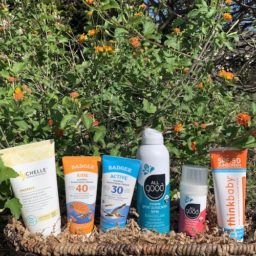 The dirty truth is, there are several chemicals in traditional sunscreens that cause endocrine disruption and even have carcinogenic properties. I know what you are thinking. You wear sunscreen so you don’t get skin cancer – how can sunscreen products potentially cause cancer and mess with my hormones? The answer to this question should be of interest to anyone and everyone but this information is even more essential for pregnant women, nursing women, and people who already experience hormone balance issues.
The dirty truth is, there are several chemicals in traditional sunscreens that cause endocrine disruption and even have carcinogenic properties. I know what you are thinking. You wear sunscreen so you don’t get skin cancer – how can sunscreen products potentially cause cancer and mess with my hormones? The answer to this question should be of interest to anyone and everyone but this information is even more essential for pregnant women, nursing women, and people who already experience hormone balance issues.
Let’s look at four ingredients commonly found in popular sunscreens, sport spf 60+ sweat and waterproof; and how these chemicals cause health issues:
- Avobenzone: Avobenzone is often used with other active ingredients in sunscreens because it is not stable on its own. When avobenzone breaks down it can cause allergic reactions. Avobenzone also has been studied for its anti-androgen activity and it has been shown to block the effects of testosterone in cellular studies. Anti-androgen activity is a major concern for both men and women but imagine the possible effect on young males who are applying sunscreens with this ingredient consistently for sports and play.
- Homosalate: It is an organic compound that prevents direct skin exposure to the sun’s harmful effects by absorbing short-wave UVB rays. Although this sounds useful as an ingredient in sunscreen, this compound penetrates the skin which makes it a concern to pregnant people and those nursing. A study in 2004 showed that homosalate increased the absorption of herbicide 2,4-D in mice wearing a sunscreen with homosalate and DEET. It’s important to note that the European Commission recommends a max concentration of 1.4 percent because of concerns about potential endocrine disruption.
- Octisalate: Octisalate is one of the 12 sunscreen ingredients the FDA requested safety and efficacy data for. A case report published in 2007 showed that the chemical can be linked to allergic contact dermatitis. The EPA suggests that octisalate may have endocrine effects and can weakly bind to estrogen receptors.
- Octocrylene: A compound that not only has the potential to disrupt your hormones but also hurt aquatic life and damage coral health. It is a compound that is excellent at absorbing through the skin, but perhaps all too well. It can absorb at levels 14 times higher than the FDA cutoff for systemic exposure. A study has also shown that octocrylene alters the development of brain and liver in zebrafish.
The two ugly ingredients some traditional sunscreens are avoiding:
- Oxybenzone: This is the active ingredient in some sunscreens you really want to avoid slathering on your and your family’s bodies. Researchers found that adolescent boys with higher levels of this compound also have lower testosterone levels. Female exposure of oxybenzone may be linked to endometriosis. The National Toxicology Program found evidence that in rats, oxybenzone could increase thyroid tumors and uterine hyperplasia. Several countries have banned the use of sunscreens with this ingredient because it is so harmful to aquatic life.
- Octinoxate: This is also another sunscreen compound banned in several countries because of its harm to aquatic life. This compound can be found in blood 16 times above the proposed FDA safety threshold. Animal studies show this compound may have an effect on thyroid hormone production and hormones that affect the metabolic system. After you apply this to your skin, it continues to absorb and can cause allergic reactions after exposure to ultraviolet lights.
Some traditional sunscreens are hip to the fact that oxybenzone and octinoxate are two ingredients that are harmful to our bodies and the environment, so they advertise on the front of the bottle or package that they are free of these compounds. Don’t be fooled – make sure you look at the active ingredients they use. Even the inactive ingredients, which can make up to 70% of a sunscreen, can contain parabens, which are ingredients that can also cause hormone disruption.
So what ingredients are safe and effective for sun protection?
Zinc oxide and titanium dioxide are what you want as the active ingredients in your sunblock to keep you protected and safe. Mineral-based sunblocks carried in our wellness departments like Badger, All Good, Think Sport and MyChelle contain about 16-25% zinc oxide as the active ingredient. An added benefit of using these mineral based sunblocks is that the inactive ingredients often contain aloe vera, calendula flower, rose hip extract, vitamin E, jojoba oil and sea buckthorn extract. These ingredients tend to soothe and nourish our skin and are ok for those with sensitive skin.
I love that these sunblocks are also reef safe and cruelty free! Make this the summer you make the switch to more natural, yet effective, sunblocks that are safer for your body and marine life.
Want to know more and stay educated on the topic of the potential dangers of ingredients in sunscreens and body care products? Check out EWG.org.

Looking to dig in a little deeper and work with a practitioner that can help you improve your health in 2022?
Naturopathic Doctor* Lauren Sanchez is accepting new patients at Infinity Wellness Center.
*Although licensed in other states, Naturopathic Doctors are not currently licensed in Texas.
If you have comments and/or questions about this blog, email us at blog@peoplesrx.com.
References:
Adam R Pont , Anna R Charron, Rhonda M Brand. Active ingredients in sunscreens act as topical penetration enhancers for the herbicide 2,4-dichlorophenoxyacetic acid. Toxicology and Applied Pharmacology, 2004, 348-354.
Campaign for Safe Cosmetics. Homosalate. https://www.safecosmetics.org/get-the-facts/chemicals-of-concern/homosalate/#_ednref24
Ivana Klopcic , Marija Sollner Dolenc. Endocrine Activity of AVB, 2MR, BHA, and Their Mixtures. Toxicological Sciences, 2017, 240–251.
Environmental Working Group. The trouble with ingredients in sunscreen. https://www.ewg.org/sunscreen/report/the-trouble-with-sunscreen-chemicals/
- Singh,M. H. Beck. Octyl salicylate: a new contact sensitivity. Contact Dermatitis, 2006, 48-48.
David Fivenson MD, et. Al. Sunscreens: UV filters to protect us: Part 2-Increasing awareness of UV filters and their potential toxicities to us and our environment. International Journal of Women’s Dermatology, 2021, 45-69.
Franco Scinicariello 1, Melanie C Buser. Serum Testosterone Concentrations and Urinary Bisphenol A, Benzophenone-3, Triclosan, and Paraben Levels in Male and Female Children and Adolescents: NHANES 2011-2012, 2016.
Tatsuya Kunisue,et al., Urinary Concentrations of Benzophenone-type UV Filters in US Women and Their Association with Endometriosis. Environ. Sci. Technol. 2012, 4624–4632.
Murali K. Matta, PhD, et al., Effect of Sunscreen Application on Plasma Concentration of Sunscreen Active Ingredients, JAMA, 2020, 256-267.
